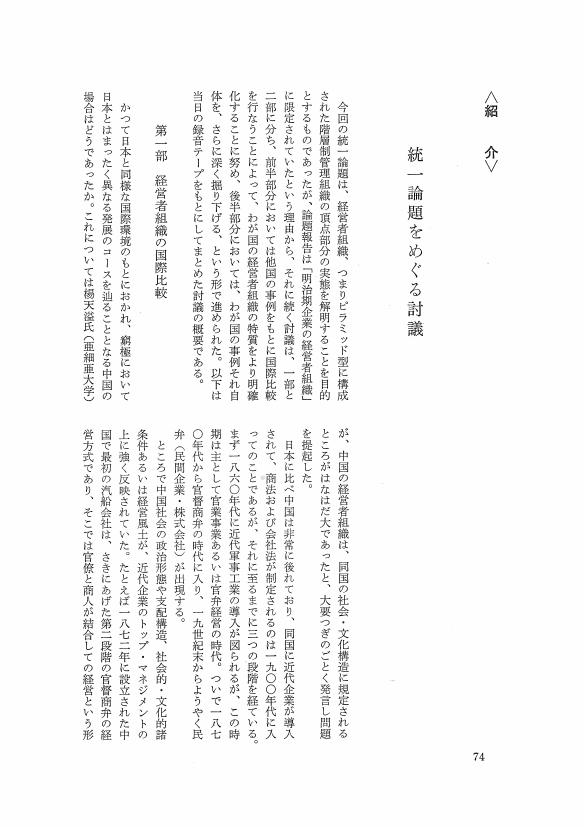1 0 0 0 OA 経営史研究の国際的動向
- 著者
- 小林 袈裟治
- 出版者
- 経営史学会
- 雑誌
- 経営史学 (ISSN:03869113)
- 巻号頁・発行日
- vol.32, no.2, pp.56-58, 1997-07-30 (Released:2009-11-06)
1 0 0 0 OA アメリカ経営史最近一〇年の成果 -工業化初期段階の研究を中心に-
- 著者
- 小林 袈裟治
- 出版者
- 経営史学会
- 雑誌
- 経営史学 (ISSN:03869113)
- 巻号頁・発行日
- vol.21, no.3, pp.76-88, 1986-10-30 (Released:2009-11-06)
1 0 0 0 OA 統一論題をめぐる討議
- 著者
- 小林 袈裟治 森川 英正
- 出版者
- 経営史学会
- 雑誌
- 経営史学 (ISSN:03869113)
- 巻号頁・発行日
- vol.14, no.1, pp.74-85, 1979-09-25 (Released:2009-11-06)
1 0 0 0 OA ビジネス・ヒストリー・コンファレンスに出席して
- 著者
- 小林 袈裟治
- 出版者
- 経営史学会
- 雑誌
- 経営史学 (ISSN:03869113)
- 巻号頁・発行日
- vol.13, no.2, pp.95-98, 1979-03-25 (Released:2010-11-18)
1 0 0 0 OA コメント2
- 著者
- 小林 袈裟治
- 出版者
- 経営史学会
- 雑誌
- 経営史学 (ISSN:03869113)
- 巻号頁・発行日
- vol.10, no.1, pp.51-53, 1975-08-25 (Released:2009-11-06)
1 0 0 0 OA コメント3
- 著者
- 小林 袈裟治
- 出版者
- 経営史学会
- 雑誌
- 経営史学 (ISSN:03869113)
- 巻号頁・発行日
- vol.7, no.1, pp.61-64, 1972-05-30 (Released:2009-11-06)
1 0 0 0 OA アメリカ農業機械工業におけるレイオフ制 マッコーミック収穫機会社の事例
- 著者
- 小林 袈裟治
- 出版者
- 経営史学会
- 雑誌
- 経営史学 (ISSN:03869113)
- 巻号頁・発行日
- vol.5, no.3, pp.34-50, 1971-08-25 (Released:2010-11-18)
The pay roll books of the McCormick works in Chicago show us the fact that, through the later part of the nineteenth century, the production of the reaping machine has been done with a kind of seasonal rhythm reached the peak in June. The peak was then followed by the sharp decline in employment which was practiced through a layoff, especilly, of the unskilled workers.Although this came from the historical fact that the reaper production was linked with the harvest season of the crops such as winter wheat, a layoff was, eventually, institutionalized in the industry.This paper intends to throw some lights on the labor management and examine the entrepreneurial significance of the layoff system on the growth of the enterprise.
1 0 0 0 OA 経営史学会年次大会に出席して
- 著者
- 小林 袈裟治
- 出版者
- 経営史学会
- 雑誌
- 経営史学 (ISSN:03869113)
- 巻号頁・発行日
- vol.4, no.2, pp.92-94, 1969-10-25 (Released:2009-11-11)
1 0 0 0 OA 北部ニュー・イングランドの木綿工業 -アモスキーグ製造会社の経営史-
- 著者
- 小林 袈裟治
- 出版者
- 経営史学会
- 雑誌
- 経営史学 (ISSN:03869113)
- 巻号頁・発行日
- vol.2, no.2, pp.64-84,iii, 1967-09-30 (Released:2009-11-11)
This paper deals with a cotton manufacturing company in Manchester, New Hampshire, promoted by a group of entrepreneurs known as the “Boston Associates.” Started as a small establishment in the 1830's, this company had grown in the space of a century to one of the largest-scale and highest quality companies in the industry. But though the mills in Manchester were firmly established, the management of the company in Boston was totally unsuited to meeting the changing situation in the early 20th century. One of the causes of the company's bankruptcy in the 1930's was attributed to mismanagement by the executives.With an emphasis on the functions, respectively, of the company treasurer and of the local mill agent, this paper analyzes the relationship between decision-making and execution, and discusses some of the characteristics of business enterprises controlled by the so-called general entrepreneurs of 19th century America.






